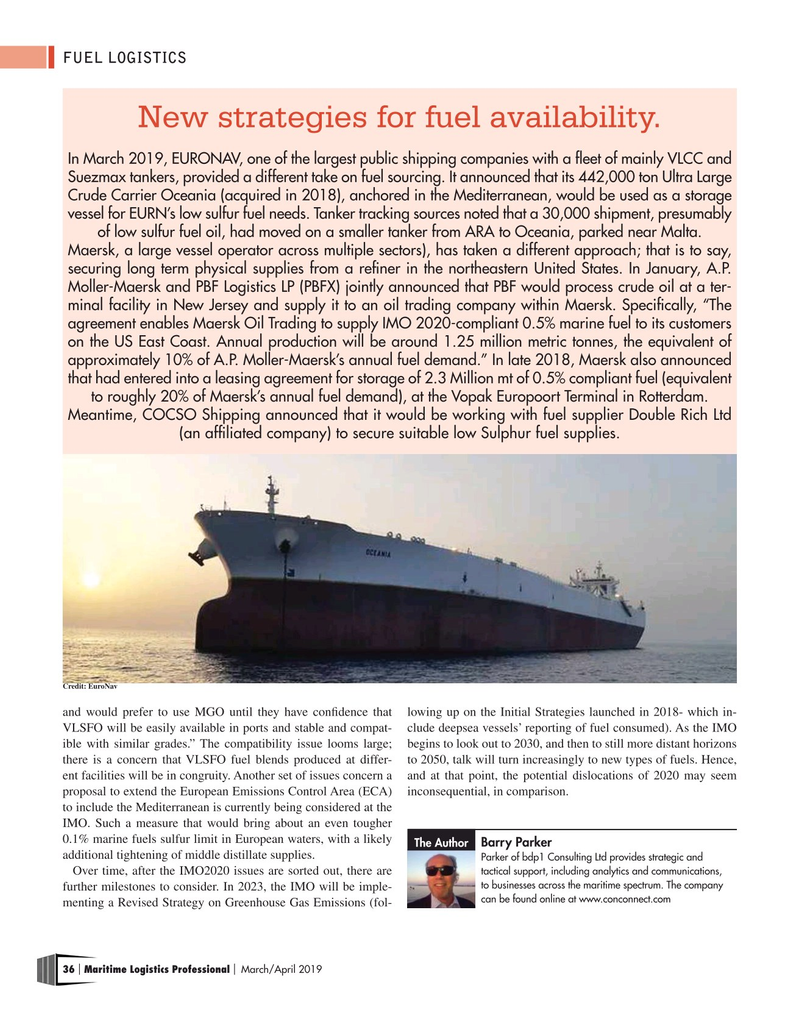
Page 36: of Maritime Logistics Professional Magazine (Mar/Apr 2019)
Container Ports
Read this page in Pdf, Flash or Html5 edition of Mar/Apr 2019 Maritime Logistics Professional Magazine
FUEL LOGISTICS
New strategies for fuel availability.
In March 2019, EURONAV, one of the largest public shipping companies with a ?eet of mainly VLCC and
Suezmax tankers, provided a different take on fuel sourcing. It announced that its 442,000 ton Ultra Large
Crude Carrier Oceania (acquired in 2018), anchored in the Mediterranean, would be used as a storage vessel for EURN’s low sulfur fuel needs. Tanker tracking sources noted that a 30,000 shipment, presumably of low sulfur fuel oil, had moved on a smaller tanker from ARA to Oceania, parked near Malta.
Maersk, a large vessel operator across multiple sectors), has taken a different approach; that is to say, securing long term physical supplies from a re?ner in the northeastern United States. In January, A.P.
Moller-Maersk and PBF Logistics LP (PBFX) jointly announced that PBF would process crude oil at a ter- minal facility in New Jersey and supply it to an oil trading company within Maersk. Speci?cally, “The agreement enables Maersk Oil Trading to supply IMO 2020-compliant 0.5% marine fuel to its customers on the US East Coast. Annual production will be around 1.25 million metric tonnes, the equivalent of approximately 10% of A.P. Moller-Maersk’s annual fuel demand.” In late 2018, Maersk also announced that had entered into a leasing agreement for storage of 2.3 Million mt of 0.5% compliant fuel (equivalent to roughly 20% of Maersk’s annual fuel demand), at the Vopak Europoort Terminal in Rotterdam.
Meantime, COCSO Shipping announced that it would be working with fuel supplier Double Rich Ltd (an af?liated company) to secure suitable low Sulphur fuel supplies.
Credit: EuroNav and would prefer to use MGO until they have con?dence that lowing up on the Initial Strategies launched in 2018- which in-
VLSFO will be easily available in ports and stable and compat- clude deepsea vessels’ reporting of fuel consumed). As the IMO ible with similar grades.” The compatibility issue looms large; begins to look out to 2030, and then to still more distant horizons there is a concern that VLSFO fuel blends produced at differ- to 2050, talk will turn increasingly to new types of fuels. Hence, ent facilities will be in congruity. Another set of issues concern a and at that point, the potential dislocations of 2020 may seem proposal to extend the European Emissions Control Area (ECA) inconsequential, in comparison. to include the Mediterranean is currently being considered at the
IMO. Such a measure that would bring about an even tougher 0.1% marine fuels sulfur limit in European waters, with a likely
Barry Parker
The Author additional tightening of middle distillate supplies.
Parker of bdp1 Consulting Ltd provides strategic and tactical support, including analytics and communications,
Over time, after the IMO2020 issues are sorted out, there are to businesses across the maritime spectrum. The company further milestones to consider. In 2023, the IMO will be imple- can be found online at www.conconnect.com menting a Revised Strategy on Greenhouse Gas Emissions (fol- 36 Maritime Logistics Professional March/April 2019 | |

 35
35

 37
37
